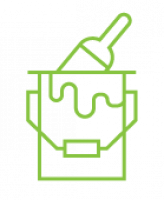THEP uses the term ‘lead in paint’ when any level of lead is detected in paint. This is because paint with lower lead levels than ‘lead-based paint’ can still be a risk to children when in poor condition such as peeling, flaking or chipping.
THEP’s intent is to use the most stringent regulations available. There is currently no known safe level of lead exposure.
The term ‘lead-based paint’ generally refers to paint produced before 1960 that contained higher levels of lead than newer paint. Lead-based paint is defined in the US as paint containing more than 5000 parts per million (ppm) or 1 mg/cm2 of lead.
In June 2024, THEP shifted its paint reporting reference point from the US Environmental Protection Agency lead-based paint standard to Canada’s Surface Coating Materials regulation[1] for lead in paint.
[1] Surface Coating Materials Regulation, SOR/2016-193, Canada Consumer Product Safety Act. 2022-12-19.




